While the U.S. employment situation report on Friday left equity investors upbeat, it certainly upset those dealing in currencies - and for the same reason. While slower employment growth and fewer U.S. interest rate increases is good news to equity investors, currency traders saw the chances of a diminishing spread in interest rates as bad news. The dollar had already been on a slippery downward slope during the week as investors anticipated interest rate increases in Europe, the UK and even Japan. However, the downward revisions to prior month's data combined with April's weaker-than-expected jobs growth and stronger-than-expected wage growth were too much for the dollar and it sank like a lead balloon.
Global Stock Market Recap
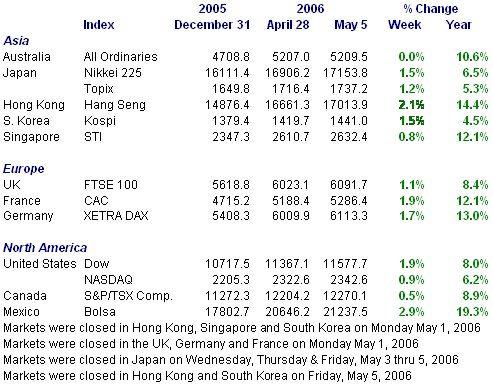
Europe and the UK
European equities largely shrugged off the interest rate speculation, and joined in a global stock rally that was fueled by strong earnings and an easing in oil prices to below $70 a barrel. It was a short trading week, with the three markets closed on Monday for the May day holiday. The CAC and DAX managed to recoup the previous week's losses and then some. However, the FTSE did not and remained below the 6100 level.

BOE and ECB do the expected
Bank of England
Much to no one's surprise, the Bank of England's Monetary Policy Committee left its policy interest rate at 4.5 percent Thursday for the ninth month in a row. Recent data have shown an improvement in the lackluster economy with first quarter gross domestic product up 2.2 percent on the year. Overall, the economy looks better balanced, with manufacturing making a modest come back. The CPI was slightly below the Bank's 2 percent inflation target in March, at 1.8 percent. The housing market is picking up steam as it heads into the busy spring season. The Halifax reported that house prices are up 8 percent on the year; but these data were accompanied by reports of stronger activity in the manufacturing and services sectors.

ECB
As widely advertised, the European Central Bank held its policy interest rate at 2.5 percent. It is also widely expected that there will be a rate increase at the June meeting. At his April news conference, ECB President Jean Claude Trichet was unexpectedly dovish. But during a news conference after Thursday's meeting, Trichet, in his most explicit language yet, indicated that the bank was considering further increases if the economy continues to grow as the bank expects. Recent data have pointed to signs of an ongoing economic recovery, strengthening the view that the ECB will continue to increase interest rates. Both pillars of monetary policy have been above ECB target rates. Inflation as measured by the harmonized index of consumer prices was up 2.4 percent on the year in April while the M3 money supply three-month moving average is up by 8.1 percent on the year. The ECB's targets are 2 percent and 4.5 percent respectively. The increasingly strong euro combined with climbing bond yields are helping the ECB by doing some of its tightening.
Asia/Pacific
There was little news from Asian markets - investors were on vacation for most of the week. Despite the hoopla about the great performance of the Nikkei and Topix, the Hang Seng has soared by 14.4 percent so far this year, while the STI has vaulted by 12.1 percent. The all ordinaries follows - it is up 10.6 percent on the year.
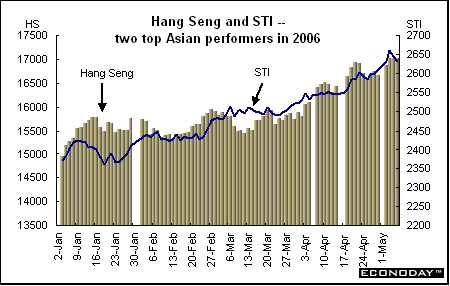
One group of Japanese stocks that have risen spectacularly has been the Tokyo Stock Exchange's property stock sub-index which has soared 102 percent since the beginning of last year. Hedge funds have been doing much of the buying with the view that property stocks have been kept artificially low by memories of the country's 1990s property crash - memories no longer relevant at a time when property prices are beginning to rise. They also believe that property stocks will benefit from Japan's improving economy, which is likely to boost demand for office and commercial space. Moreover, real estate shares benefited from foreign institutional investors' preference for domestic stocks that allowed them exposure to Japan's recovery. Many Japanese property investors have been encouraged by the central bank's zero interest rate policy to take on more loans. That enthusiasm is likely to be curtailed when interest rates start to rise.
The RBA surprises
In this wonderful era of central bank transparency some decisions still have the capability to surprise. On Wednesday, the Reserve Bank of Australia managed to shock the financial markets and increase their key interest rate by 25 basis points to 5.75 percent. The unexpected increase in its official interest rate was attributed to record oil costs and rising wages that threaten to push up prices. This was the first rate increase in 14 months and the highest interest rate in more than five years. The RBA has a target inflation range of 2 to 3 percent over the business cycle (its last recession was June 1990 to December 1991). Its latest consumer price index reading for the first quarter was 3 percent. The Bank also might be concerned that wage growth will add to inflationary pressures. Unemployment is at a 29 year low of 5 percent. A wage cost index was up 4.2 percent in the fourth quarter from a year earlier.

The Australian dollar was up on the news. The increase could make the interest rate gap between U.S. and Australian bonds more attractive to investors, especially if the FOMC takes a break in their series of interest rate increases after its May meeting. The Australian dollar, which is close a seven month high, could strengthen even more if investors seek higher bond yields there. Australian government two-year bonds are yielding about 5.7 percent, 76 basis points more than their U.S. counterparts at this writing.
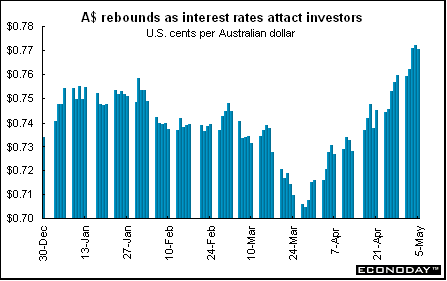
The Australian dollar slipped Friday against its U.S. namesake after the Reserve Bank's quarterly monetary policy statement suggested that the rate increase might not be repeated any time soon. The statement suggested that this week's increase was in response to intensified inflation risks but that it was a one off pre-emptive strike rather than a start of a tightening cycle.
Currencies
The U.S. dollar dropped against all major currencies last week, including the pound sterling, yen, euro, Swiss franc and Canadian and Australian dollars.
The Canadian dollar vaulted above the 90 U.S. cent level for the first time in 28 years on Tuesday. Investors think the Bank of Canada will keep increasing borrowing costs as the economy benefits from a boom in oil and soaring commodity prices. The Bank increased its key interest rate to 4 percent on April 25th and suggested that more may be on the horizon to stem inflation. The Canadian dollar has climbed 5 percent against its U.S. counterpart so far this year, following four straight annual gains. It is up about 45 percent since touching 61.80 U.S. cents in January 2002. The last time the Canadian currency traded at parity with the U.S. dollar was in 1976.
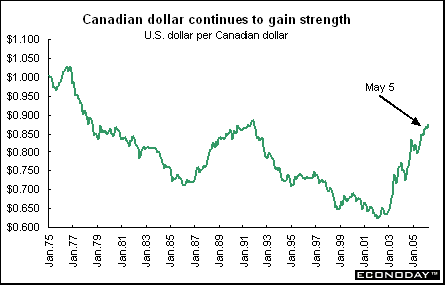
Asian currencies including the yen drifted lower Thursday as Sadakazu Tanigaki, the Japanese finance minister, added his voice to claims that the recent Group of Seven finance ministers meeting did not call for dollar depreciation against Asian currencies. In the two weeks of trading since the G7, several currencies have risen to their highest levels against the dollar since the 1997-98 Asian crisis. The statement released after the meeting reiterated a call for greater currency flexibility in an effort to reduce global imbalances.
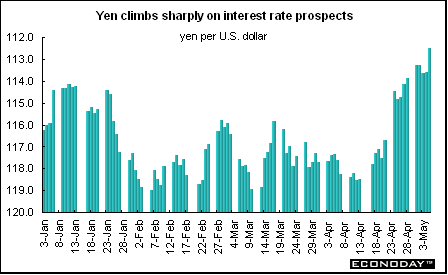
But the dollar sank Friday after the employment report disappointed traders. The dollar fell to the lowest in almost a year against the euro and tumbled against the yen after the U.S. added fewer jobs than forecast in April. This in turn bolstered speculation that the Federal Reserve would soon stop increasing interest rates.
The euro benefited on Thursday from hawkish hints as ECB President Trichet stepped up the rhetoric on the inflation risks from sky-rocketing oil costs. The remarks were seen as confirmation that an interest rate increase would occur at the ECB's meeting on June 1st. This sent the euro to a year-high against the dollar. ECB watchers pointed to the reemergence of the world 'vigilance' in Trichet's press conference, last used prior to the March rate increase. They noted that he used the 'v' word three times. The reaction to the employment report put further pressure on the U.S. dollar and the euro continued to climb.

Indicator scoreboard
EMU - April seasonally adjusted manufacturers purchasing managers' index climbed to 56.7 from 56.1 in March. Both input and output prices were up. An index value above 50 indicates growth. The index is prepared by NTC Research in the UK. Of the major countries, the index readings for France and Italy were up while Germany remained unchanged and Spain declined. The indexes in the UK and the U.S. both experienced healthy increases in April.
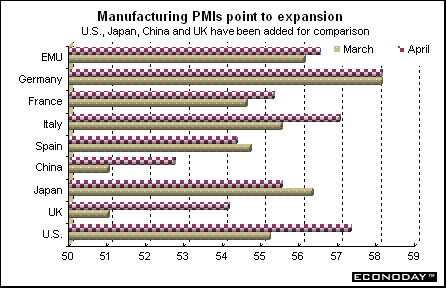
March seasonally and workday adjusted retail sales were down 0.8 percent and dropped 0.1 percent when compared with last year. Food, drinks and tobacco sales sank 1 percent on the month while non-food sales were down 0.5 percent. These data, based on uncorrected national data that are then adjusted by Eurostat, differ from the national releases.

March industrial prices were up 0.4 percent and 5.1 percent when compared with last year. The core PPI which excludes energy in addition to construction was up 1.8 percent on the month. Energy prices were up 0.8 percent and 17.4 percent on the year.
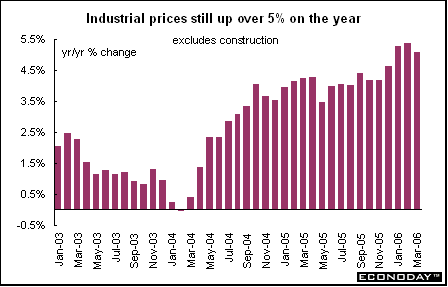
April seasonally adjusted unemployment rate edged down to 8.1 percent from 8.2 percent in March. This is the lowest rate of unemployment since April 2002.

Asia
Australia - March seasonally adjusted merchandise trade deficit expanded to A$1.545 billion from A$415 million in February. Exports sank by 5.2 percent while imports were up 1.4 percent. Non-rural exports dropped 9 percent while rural goods exports were up 7 percent. Both capital goods and consumer goods imports were up 1 percent.
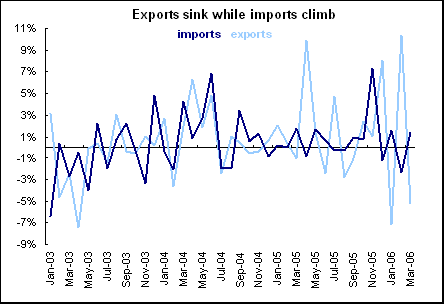
Americas
Canada - March industrial product price index (IPPI) was up 0.8 percent and 1.1 percent when compared with last year. Higher prices for petroleum products, primary metal products and motor vehicles & other transport equipment were the major contributors to this monthly increase. Petroleum and primary metal products contributed to the annual change. The IPPI excluding petroleum and coal was up 0.2 percent on the year.
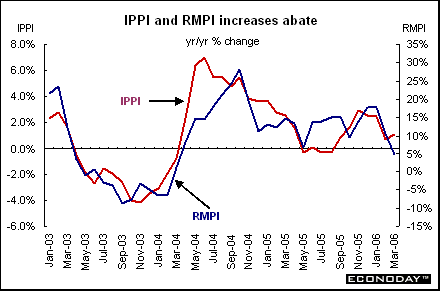
March raw materials price index (RMPI) was up 0.8 percent and 4.9 percent when compared with last year. Non-ferrous metals were the major contributors to this monthly increase as prices rose 4.0 percent. Prices for zinc concentrates, radio-active concentrates, copper concentrates, silver and gold were up due to strong demand and tight supply. On a 12-month basis, mineral fuels were up 3.8 percent and natural gas prices were up 25.3 percent. If mineral fuels had been excluded, the RMPI would have increased 6.2 percent instead of rising 4.9 percent.
In March, the value of the Canadian dollar against the U.S. dollar was down 0.7 percent. As a result, the total IPPI excluding the effect of the exchange would have been up 0.6 percent instead of its actual increase of 0.8 percent. On a 12-month basis, the value of the Canadian dollar rose 5.1 percent against the U.S. dollar. If the impact of the exchange rate had been excluded, producer prices would have increased 2.4 percent on the year rather than their actual increase of 1.1 percent.
April employment was up by 22,000 jobs while the unemployment rate edged up to 6.4 percent as 24,900 persons entered the labor force. Full time jobs were up by 26,000 while part time jobs declined by 4,000 jobs. Manufacturing jobs increased by 25,000 while retail and wholesale trade added 20,000 new jobs. However, transportation and warehousing employment sank by 15,000 jobs. Average hourly wages were up 3.1 percent when compared with April 2005. Not surprisingly, the hourly wage rate growth continued to be highest in the oil and gas producing province of Alberta.
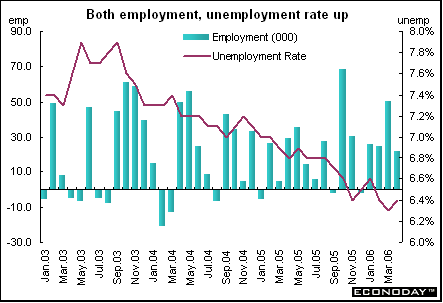
Bottom line
Now that the U.S. employment situation report has been released, investors will shift their focus to Wednesday's FOMC meeting. Although a rate increase is expected, investors will be dissecting the post-meeting statement to see if the long awaited pause will become a reality in June. The week also brings the first look at GDP for Germany, Italy and the EMU. Since no detail will be available with those flash releases, investors will have to hold their curiosity for another week to 10 days before they learn which sectors grew and which did not.

